Particle Size Distribution Effects on the Strength Characteristic of Cemented Paste Backfill
Abstract
:1. Introduction
2. Materials and Methods
2.1. Experimental Materials
2.2. Experimental Specimens
2.3. Experimental Equipment and Testing Parameters
3. Results and Discussion
3.1. Confining Pressure and the Particle Size Distribution Effect on Stress–Strain Behavior and the AE Characteristic of CPB
3.2. Effects of Particle Size Distribution on the Strength Parameters of CPB
3.3. The Coupled Effect of Confining Pressure and Particle Size Distribution on the Strength Parameters of CPB
4. Conclusions
- (1)
- The confining pressure not only increases the peak strength and compressibility of CPB, but also greatly increases its ductility. With the increase of confining pressure, CPB is transformed from demonstrating the strain softening characteristic under uniaxial compression to the strain hardening characteristic under triaxial compression. The material must have two points at the same time to achieve this ductility characteristic under confining pressure. The first is that the new cracks continuously expand and propagate. The second is that the already opened cracks require constant compression and occlusal friction. Therefore, under the condition of confining pressure, the AE characteristic of CPB specimens show that small AE signals distribute around the large AE signals. This is obviously different from the AE characteristic under uniaxial compression.
- (2)
- This ductility and the dilatancy deformation of CPB are positively correlated with the Talbot index of particles. In addition, in the CPB specimens with a Talbot index of 0.2, since they contain too many fine particles, the density and intensity of the AE distribution and the peak strength are the lowest among all the specimens.
- (3)
- The peak strength of the CPB specimen first increases and then decreases with the increase of the Talbot index, and the relationship between the peak strength and the Talbot index can be described by a quadratic polynomial function. The extremum of the function in the Talbot gradation range can be used to characterize the optimal gradation of particles reflected by the maximum strength of the CPB material, for which the optimal Talbot index is between 0.4 and 0.6.
- (4)
- The established strength parameter model of CPB under the coupled influence of the confining pressure and the particle size distribution is related to the cohesiveness and internal friction properties of the material, and each parameter has a definite physical meaning. Under the conditions of this paper, the model can effectively reflect the influence of the confining pressure and the particle size distribution on the peak strength of CPB, and can also reflect the influence of the particle size distribution on the cohesive force and internal friction angle of CPB.
Author Contributions
Acknowledgments
Conflicts of Interest
References
- Khoshand, A.; Fall, M. Geotechnical characterization of peat-based landfill cover materials. J. Rock Mech. Geotech. Eng. 2016, 6, 1–9. [Google Scholar] [CrossRef]
- Deng, D.Q.; Liu, L.; Yao, Z.L.; Song, K.; Lao, D.Z. A practice of ultra-fine tailings disposal as filling material in a gold mine. J. Environ. Manag. 2017, 196, 100–109. [Google Scholar] [CrossRef] [PubMed]
- Li, M.; Zhang, J.X.; Zhou, N.; Huang, Y.L. Effect of Particle Size on the Energy Evolution of Crushed Waste Rock in Coal Mines. Rock Mech. Rock Eng. 2017, 50, 1–8. [Google Scholar] [CrossRef]
- Li, X.B.; Li, D.Y.; Liu, Z.X.; Zhao, G.Y.; Wang, W.H. Determination of the minimum thickness of crown pillar for safe exploitation of a subsea gold mine based on numerical modelling. Int. J. Rock Mech. Min. Sci. 2013, 57, 42–56. [Google Scholar] [CrossRef]
- Zhang, J.X.; Li, B.Y.; Zhou, N.; Zhang, Q. Application of solid backfilling to reduce hard-roof caving and longwall coal face burst potential. Int. J. Rock Mech. Min. Sci. 2016, 88, 197–205. [Google Scholar] [CrossRef]
- Zhang, K.; Yang, T.H.; Bai, H.B.; Gamage, R.P. Longwall mining–induced damage and fractures: Field measurements and simulation using FDM and DEM coupled method. Int. J. Geomech. 2018, 18, 04017127. [Google Scholar] [CrossRef]
- Sivakugan, N.; Rankine, R.M.; Rankine, K.J.; Rankine, K.S. Geotechnical considerations in mine backfilling in Australia. J. Clean. Prod. 2006, 14, 1168–1175. [Google Scholar] [CrossRef]
- Abdul-Hussain, N.; Fall, M. Thermo-hydro-mechanical behaviour of sodium silicate-cemented paste tailings in column experiments. Tunn. Undergr. Space Technol. 2012, 29, 85–93. [Google Scholar] [CrossRef]
- Holt, E.; Leivo, M. Cracking risks associated with early age shrinkage. Cem. Concr. Compos. 2004, 26, 521–530. [Google Scholar] [CrossRef]
- Ouellet, S.; Bussière, B.; Aubertin, M.; Benzaazoua, M. Characterization of cemented paste backfill pore structure using SEM and IA analysis. Bull. Eng. Geol. Environ. 2008, 67, 139–152. [Google Scholar] [CrossRef]
- Wu, A.X.; Wang, Y.; Wang, H.J.; Yin, S.H.; Miao, X.X. Coupled effects of cement type and water quality on the properties of cemented paste backfill. Int. J. Min. Process. 2015, 143, 65–71. [Google Scholar] [CrossRef]
- Ouellet, S.; Bussière, B.; Mbonimpa, M.; Benzaazoua, M.; Aubertin, M. Reactivity and mineralogical evolution of an underground mine sulphidic cemented paste backfill. Miner. Eng. 2006, 19, 407–419. [Google Scholar] [CrossRef]
- Fall, M.; Benzaazoua, M.; Saa, E.G. Mix proportioning of underground cemented tailings backfill. Tunn. Undergr. Space Technol. 2008, 23, 80–90. [Google Scholar] [CrossRef]
- Koohestani, B.; Koubaa, A.; Belem, T.; Bussière, B.; Bouzahzah, H. Experimental investigation of mechanical and microstructural properties of cemented paste backfill containing maple-wood filler. Constr. Build. Mater. 2016, 121, 222–228. [Google Scholar] [CrossRef]
- Ercikdi, B.; Cihangir, F.; Kesimal, A.; Deveci, H.; Alp, İ. Utilization of water-reducing admixtures in cemented paste backfill of sulphide-rich mill tailings. J. Hazard. Mater. 2010, 179, 940–946. [Google Scholar] [CrossRef] [PubMed]
- Koohestani, B.; Darban, A.K.; Mokhtari, P. A comparison between the influence of superplasticizer and organosilanes on different properties of cemented paste backfill. Constr. Build. Mater. 2018, 173, 180–188. [Google Scholar] [CrossRef]
- Koohestani, B.; Bussière, B.; Belem, T.; Koubaa, A. Influence of polymer powder on properties of cemented paste backfill. Int. J. Min. Process. 2017, 167, 1–8. [Google Scholar] [CrossRef]
- Koohestani, B. Effect of saline admixtures on mechanical and microstructural properties of cementitious matrices containing tailings. Constr. Build. Mater. 2017, 156, 1019–1027. [Google Scholar] [CrossRef]
- Pourjavadi, A.; Fakoorpoor, S.M.; Hosseini, P.; Khaloo, A. Interactions between superabsorbent polymers and cement-based composites incorporating colloidal silica nanoparticles. Cem. Concr. Compos. 2013, 37, 196–204. [Google Scholar] [CrossRef]
- Koohestani, B.; Belem, T.; Koubaa, A.; Bussière, B. Experimental investigation into the compressive strength development of cemented paste backfill containing Nano-silica. Cem. Concr. Compos. 2016, 72, 180–189. [Google Scholar] [CrossRef]
- Fall, M.; Célestin, J.C.; Pokharel, M.; Touré, M. A contribution to understanding the effects of curing temperature on the mechanical properties of mine cemented tailings backfill. Eng. Geol. 2010, 114, 397–413. [Google Scholar] [CrossRef]
- Fall, M.; Pokharel, M. Coupled effects of sulphate and temperature on the strength development of cemented tailings backfills: Portland cement-paste backfill. Cem. Concr. Compos. 2010, 32, 819–828. [Google Scholar] [CrossRef]
- Fall, M.; Samb, S.S. Effect of high temperature on strength and microstructural properties of cemented paste backfill. Fire Saf. J. 2009, 44, 642–651. [Google Scholar] [CrossRef]
- Ghirian, A.; Fall, M. Coupled thermo-hydro-mechanical-chemical behaviour of cemented paste backfill in column experiments. Part II: Physical, hydraulic and thermal processes and characteristics. Eng. Geol. 2013, 164, 195–207. [Google Scholar] [CrossRef]
- Jiang, H.; Fall, M.; Liang, C. Yield stress of cemented paste backfill in sub-zero environments: Experimental results. Miner. Eng. 2016, 92, 141–150. [Google Scholar]
- Yilmaz, E.; Belem, T.; Benzaazoua, M. Effects of curing and stress conditions on hydromechanical, geotechnical and geochemical properties of cemented paste backfill. Eng. Geol. 2014, 168, 23–37. [Google Scholar] [CrossRef]
- Cihangir, F.; Ercikdi, B.; Kesimal, A.; Deveci, H.; Erdemir, F. Paste backfill of high-sulphide mill tailings using alkali-activated blast furnace slag: Effect of activator nature, concentration and slag properties. Miner. Eng. 2015, 83, 117–127. [Google Scholar] [CrossRef]
- Jongpradist, P. Effective Void Ratio for Assessing the Mechanical Properties of Cement-Clay Admixtures at High Water Content. J. Geotech. Geoenviron. 2011, 137, 621–627. [Google Scholar] [CrossRef]
- Yilmaz, E.; Benzaazoua, M.; Belem, T.; Bussière, B. Effect of curing under pressure on compressive strength development of cemented paste backfill. Miner. Eng. 2009, 22, 772–785. [Google Scholar] [CrossRef]
- Liu, Z.X.; Dang, W.G.; Liu, Q.L.; Chen, G.H.; Peng, K. Optimization of clay material mixture ratio and filling process in gypsum mine goaf. Int. J. Min. Sci. Technol. 2013, 23, 337–342. [Google Scholar] [CrossRef]
- Miao, X.X.; Zhang, J.X.; Feng, M.M. Waste-filling in fully-mechanized coal mining and its application. J. China Univ. Min. Technol. 2008, 18, 479–482. [Google Scholar] [CrossRef]
- Liu, Z.X.; Li, X.B. Study on fractal gradation of tailings and knowledge bank of its cementing strength. Chin. J. Rock Mech. Eng. 2005, 24, 1789–1793. [Google Scholar]
- Yin, S.H.; Wu, A.X.; Hu, K.J.; Wang, Y.; Zhang, Y.K. The effect of solid components on the rheological and mechanical properties of cemented paste backfill. Miner. Eng. 2012, 35, 61–66. [Google Scholar] [CrossRef]
- Ke, X.; Hou, H.; Zhou, M.; Wang, Y.; Zhou, X. Effect of particle gradation on properties of fresh and hardened cemented paste backfill. Constr. Build. Mater. 2015, 96, 378–382. [Google Scholar] [CrossRef]
- Fall, M.; Benzaazoua, M.; Ouellet, S. Experimental characterization of the influence of tailings fineness and density on the quality of cemented paste backfill. Miner. Eng. 2005, 18, 41–44. [Google Scholar] [CrossRef]
- Börgesson, L.; Johannesson, L.E.; Gunnarsson, D. Influence of soil structure heterogeneities on the behaviour of backfill materials based on mixtures of bentonite and crushed rock. Appl. Clay Sci. 2003, 23, 121–131. [Google Scholar] [CrossRef]
- Yilmaz, E.; Belem, T.; Benzaazoua, M.; Kesimal, A.; Ercikdi, B. Evaluation of the strength properties of deslimed tailings paste backfill. Miner. Resour. Eng. 2013, 12, 129–144. [Google Scholar]
- Orejarena, L.; Fall, M. The use of artificial neural networks to predict the effect of sulphate attack on the strength of cemented paste backfill. Bull. Eng. Geol. Environ. 2010, 69, 659–670. [Google Scholar] [CrossRef]
- Gautam, B.P.; Panesar, D.K.; Sheikh, S.A.; Vecchio, F.J. Effect of coarse aggregate grading on the ASR expansion and damage of concrete. Cem. Concr. Res. 2017, 95, 75–83. [Google Scholar] [CrossRef]
- Liu, R.; Li, B.; Jiang, Y. Critical hydraulic gradient for nonlinear flow through rock fracture networks: The roles of aperture, surface roughness, and number of intersections. Adv. Water. Resour. 2016, 88, 53–65. [Google Scholar] [CrossRef]
- Liu, R.; Jiang, Y.; Li, B.; Yu, L. Estimating permeability of porous media based on modified Hagen–Poiseuille flow in tortuous capillaries with variable lengths. Microfluid. Nanofluid. 2016, 20, 120. [Google Scholar] [CrossRef]
- Yilmaz, E.; Benzaazoua, M.; Bussière, B.; Kesimal, A.; Ercikdi, B. Influence of disposal configurations on hydrogeological behaviour of sulphidic paste tailings: A field experimental study. Int. J. Miner. Process. 2014, 131, 12–25. [Google Scholar] [CrossRef]
- Ke, X.; Zhou, X.; Wang, X.; Wang, T.; Hou, H.B.; Zhou, M. Effect of tailings fineness on the pore structure development of cemented paste backfill. Constr. Build. Mater. 2016, 126, 345–350. [Google Scholar] [CrossRef]
- Kesimal, A.; Ercikdi, B.; Yilmaz, E. The effect of desliming by sedimentation on paste backfill performance. Miner. Eng. 2003, 16, 1009–1011. [Google Scholar] [CrossRef]
- Sari, D.; Pasamehmetoglu, A.G. The effects of gradation and admixture on the pumice lightweight aggregate concrete. Cem. Concr. Res. 2005, 35, 936–942. [Google Scholar] [CrossRef]
- Bosiljkov, V.B. SCC mixes with poorly graded aggregate and high volume of limestone filler. Cem. Concr. Res. 2003, 33, 1279–1286. [Google Scholar] [CrossRef]
- Lamontagne, A.; Pigeon, M. The influence of polypropylene fibers and aggregate grading on the properties of dry-mix shotcrete. Cem. Concr. Res. 1995, 25, 293–298. [Google Scholar] [CrossRef]
- Zhang, T.S.; Yu, Q.J.; Wei, J.X.; Zhang, P.P. A new gap-graded particle size distribution and resulting consequences on properties of blended cement. Cem. Concr. Compos. 2011, 33, 543–550. [Google Scholar] [CrossRef]
- Ashraf, W.B.; Noor, M.A. Laboratory-Scale Investigation on Band Gradations of Aggregate for Concrete. J. Mater. Civ. Eng. 2013, 25, 1776–1782. [Google Scholar] [CrossRef]
- Ma, D.; Zhou, Z.; Wu, J.; Li, Q.; Bai, H. Grain Size Distribution Effect on the Hydraulic Properties of Disintegrated Coal Mixtures. Energies 2017, 10, 612. [Google Scholar] [Green Version]
- Wu, J.Y.; Feng, M.M.; Yu, B.Y.; Chen, Z.Q.; Mao, X.B.; Han, G.S. Experimental study of strength and deformation characteristics of cemented waste rock backfills with continuous gradation. Rock Soil Mech. 2017, 38, 101–108. [Google Scholar]
- Ma, D.; Rezania, M.; Yu, H.; Bai, H. Variations of hydraulic properties of granular sandstones during water inrush: Effect of small particle migration. Eng. Geol. 2017, 217, 61–70. [Google Scholar] [CrossRef] [Green Version]
- Fall, M.; Benzaazoua, M. Modeling the effect of sulphate on strength development of paste backfill and binder mixture optimization. Cem. Concr. Res. 2005, 35, 301–314. [Google Scholar] [CrossRef]
- Cao, S.; Song, W.D.; Yilmaz, E. Influence of structural factors on uniaxial compressive strength of cemented tailings backfill. Constr. Build. Mater. 2018, 174, 190–201. [Google Scholar] [CrossRef]
- Yilmaz, E.; Belem, T.; Benzaazoua, M. Specimen size effect on strength behavior of cemented paste backfills subjected to different placement conditions. Eng. Geol. 2015, 185, 52–62. [Google Scholar] [CrossRef]
- ASTM Standard C192/C192M-13a. 2013. Standard Practice for Making and Curing Concrete Test Specimens in the Lab. Annual Book of ASTM Standards, 04.02, West Conshohocken, PA. Available online: http://dx.doi.org/10.1520/C0192_C0192M-13A (accessed on 19 September 2016).
- Ulusay, R. The ISRM Suggested Methods for Rock Characterization, Testing and Monitoring: 2007–2014; Springer International Publishing: Cham, Switzerland, 2015. [Google Scholar]
- Darlignton, W.J.; Ranjith, P.G.; Choi, S.K. The effect of specimen size on strength and other properties in lab testing of rock and rock-like cementitious brittle materials. Rock Mech. Rock Eng. 2011, 44, 513–529. [Google Scholar] [CrossRef]
- Feng, M.M.; Wu, J.Y.; Ma, D.; Ni, X.Y.; Yu, B.Y.; Chen, Z.Q. Experimental investigation on seepage property of saturated broken red sandstone of continuous gradation. Bull. Eng. Geol. Environ. 2017, 1–12. [Google Scholar] [CrossRef]
- Talbot, A.N.; Richart, F.E. The Strength of Concrete and Its Relation to the Cement, Aggregate and Water; Bulletin; Univeristy of Illinois Engineering Experiment Station: Champaign, IL, USA, 1923; Volume 137, pp. 1–118. [Google Scholar]
- Carpinteri, A.; Corrado, M.; Lacidogna, G. Heterogeneous materials in compression: Correlations between absorbed, released and acoustic emission energies. Eng. Fail. Anal. 2013, 33, 236–250. [Google Scholar] [CrossRef]
- Wu, J.Y.; Feng, M.M.; Yu, B.Y.; Han, G.S. The length of pre-existing fissures effects on the mechanical properties of cracked red sandstone and strength design in engineering. Ultrasonics 2018, 82, 188–199. [Google Scholar] [CrossRef] [PubMed]
- Wu, J.Y.; Feng, M.M.; Yu, B.Y.; Zhang, W.L.; Ni, X.Y.; Han, G.S. Experimental investigation on dilatancy behavior of water-saturated sandstone. Int. J. Min. Sci. Technol. 2018, 28, 323–329. [Google Scholar] [CrossRef]
- Yilmaz, T.; Ercikdi, B.; Karaman, K.; Külekçi, G. Assessment of strength properties of cemented paste backfill by ultrasonic pulse velocity test. Ultrasonics 2014, 54, 1386–1394. [Google Scholar] [CrossRef] [PubMed]
- Ercikdi, B.; Yilmaz, T.; Külekci, G. Strength and ultrasonic properties of cemented paste backfill. Ultrasonics 2013, 54, 195–204. [Google Scholar] [CrossRef] [PubMed]
- Hoek, E. Estimating Mohr-Coulomb friction and cohesion values from the Hoek-Brown failure criterion. Int. J. Rock Mech. Min. Sci. Geomech. Abstr. 1990, 27, 227–229. [Google Scholar] [CrossRef]
- Hoek, E.; Kaiser, P.K.; Bawden, W.F. Support of Underground Excavations in Hard Rock; Balkema: Rotterdam, The Netherlands, 1995. [Google Scholar]
- You, M.Q. Comparison of the accuracy of some conventional triaxial strength criteria for intact rock. Int. J. Rock Mech. Min. Sci. 2011, 48, 852–863. [Google Scholar] [CrossRef]
- Wu, J.Y.; Chen, Z.Q.; Feng, M.M.; Wang, Y.M.; Han, G.S. The length of pre-existing fissure effects on the dilatancy behavior, acoustic emission, and strength characteristics of cracked sandstone under different confining pressures. Environ. Earth Sci. 2018, 77, 430. [Google Scholar] [CrossRef]
- You, M.Q. True-triaxial strength criteria for rock. Int. J. Rock Mech. Min. Sci. 2009, 46, 115–127. [Google Scholar] [CrossRef]
- Li, M.; Zhang, J.X.; Huang, Y.L.; Zhou, N. Effects of particle size of crushed gangue backfill materials on surface subsidence and its application under buildings. Environ. Earth Sci. 2017, 76, 603. [Google Scholar] [CrossRef]
- Zhang, J.X.; Li, M.; Liu, Z.; Zhou, N. Fractal characteristics of crushed particles of coal gangue under compaction. Powder Technol. 2017, 305, 12–18. [Google Scholar] [CrossRef]
- Li, M.; Zhang, J.X.; Quan, K.; Zhou, N. Innovative Extraction Method for a Coal Seam with a Thick Rock-Parting for Supporting Coal Mine Sustainability. Sustainability 2017, 9, 1982. [Google Scholar] [CrossRef]
- Yilmaz, E.; Belem, T.; Benzaazoua, M. One-dimensional consolidation parameters of cemented paste backfills. Miner. Resour. Manag. 2012, 28, 29–45. [Google Scholar]
- Yilmaz, E.; Belem, T.; Bussière, B.; Benzaazoua, M. Relationships between microstructural properties and compressive strength of consolidated and unconsolidated cemented paste backfills. Cem. Concr. Compos. 2011, 33, 702–715. [Google Scholar] [CrossRef]
- Yilmaz, E.; Belem, T.; Bussière, B.; Mbonimpa, M.; Benzaazoua, M. Curing time effect on consolidation behaviour of cemented paste backfill containing different cement types and contents. Constr. Build. Mater. 2015, 75, 99–111. [Google Scholar] [CrossRef]
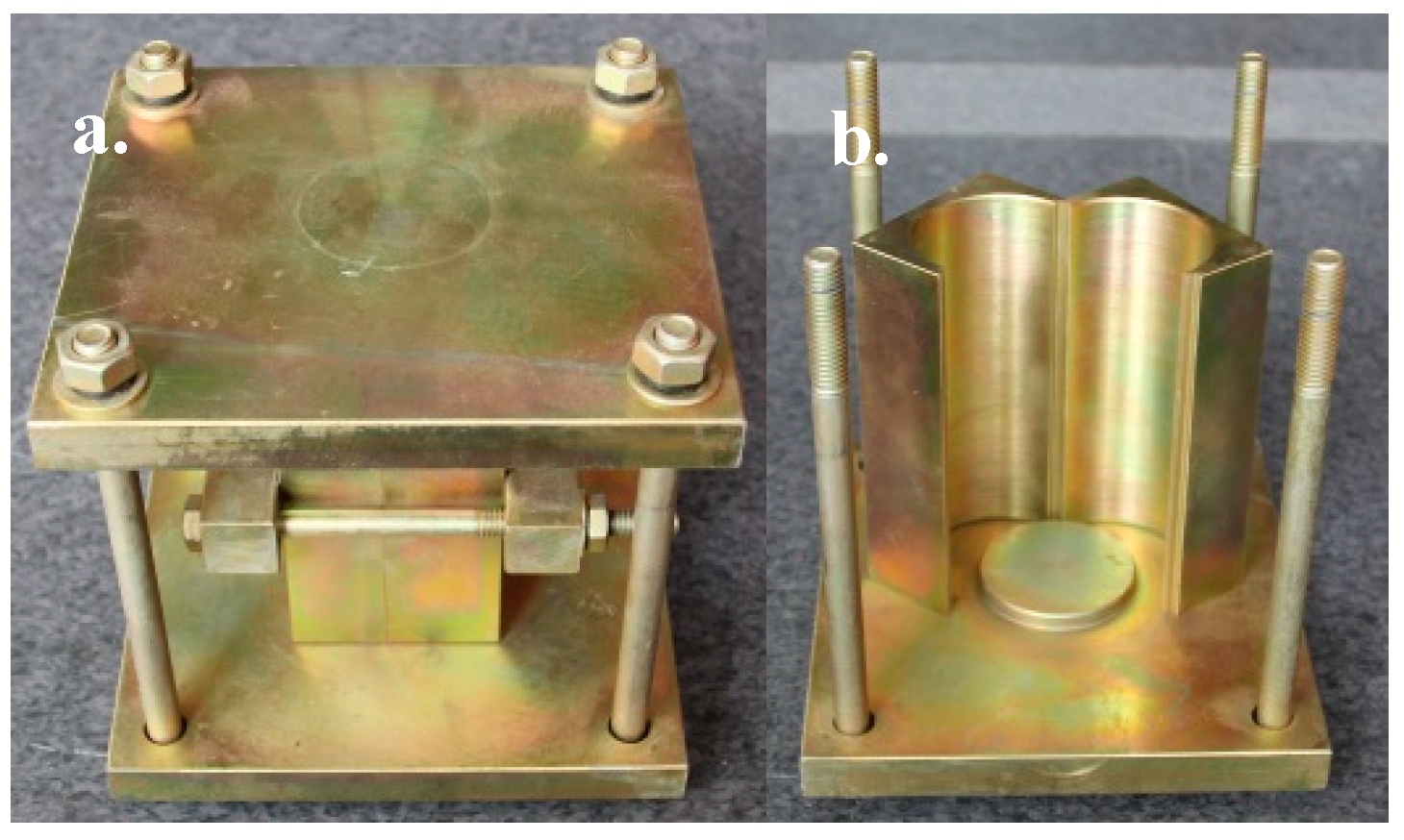
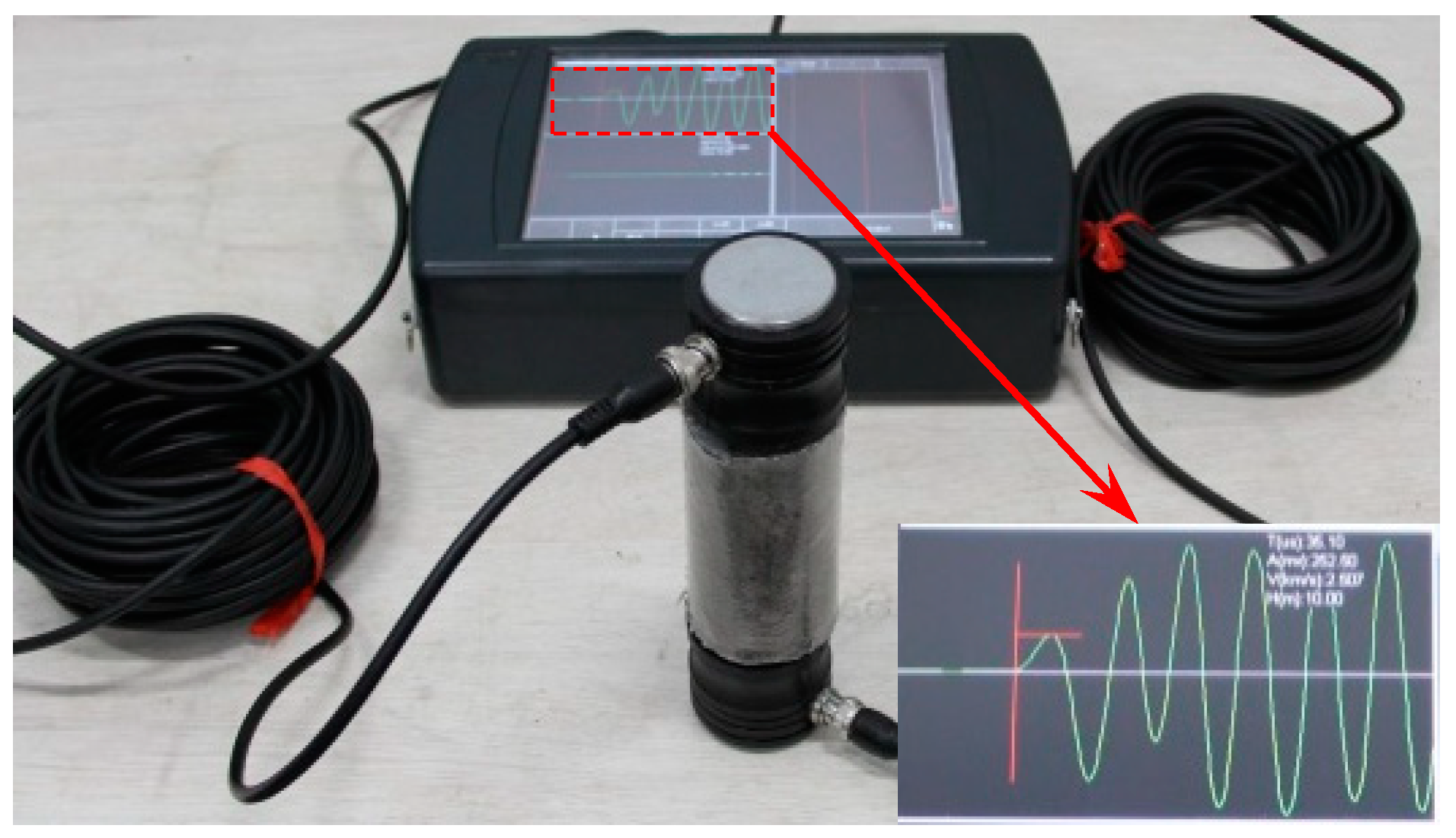
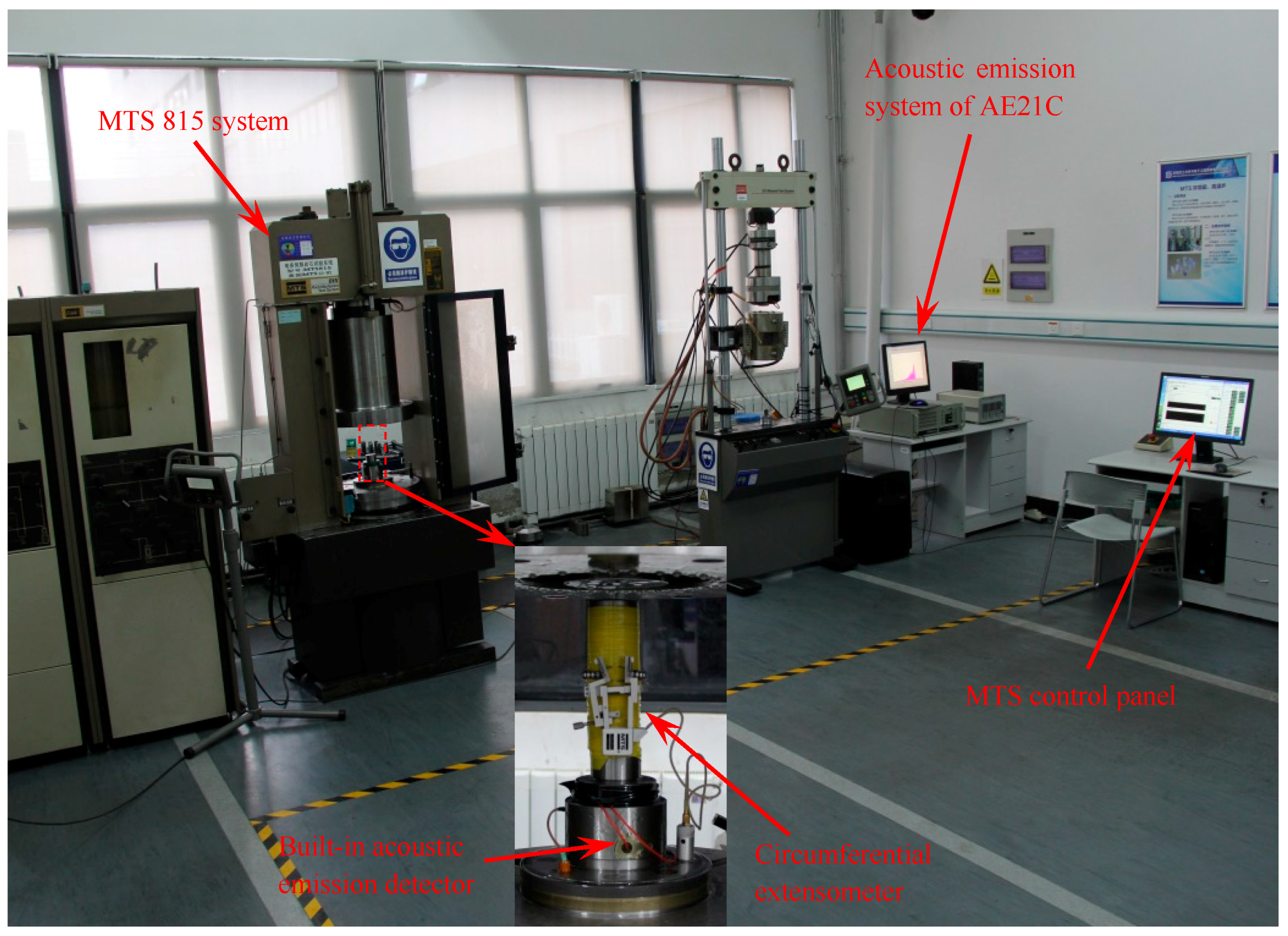
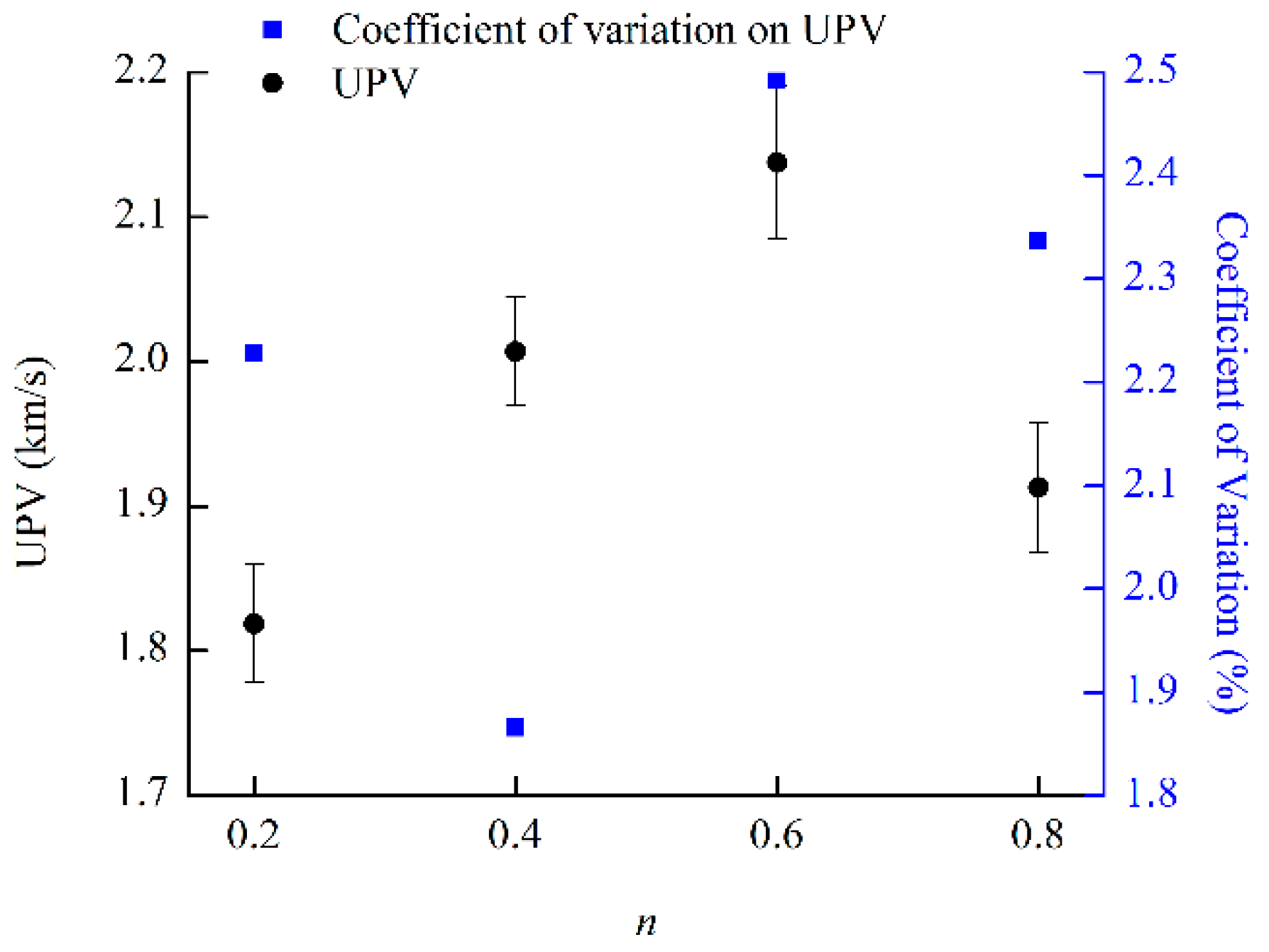
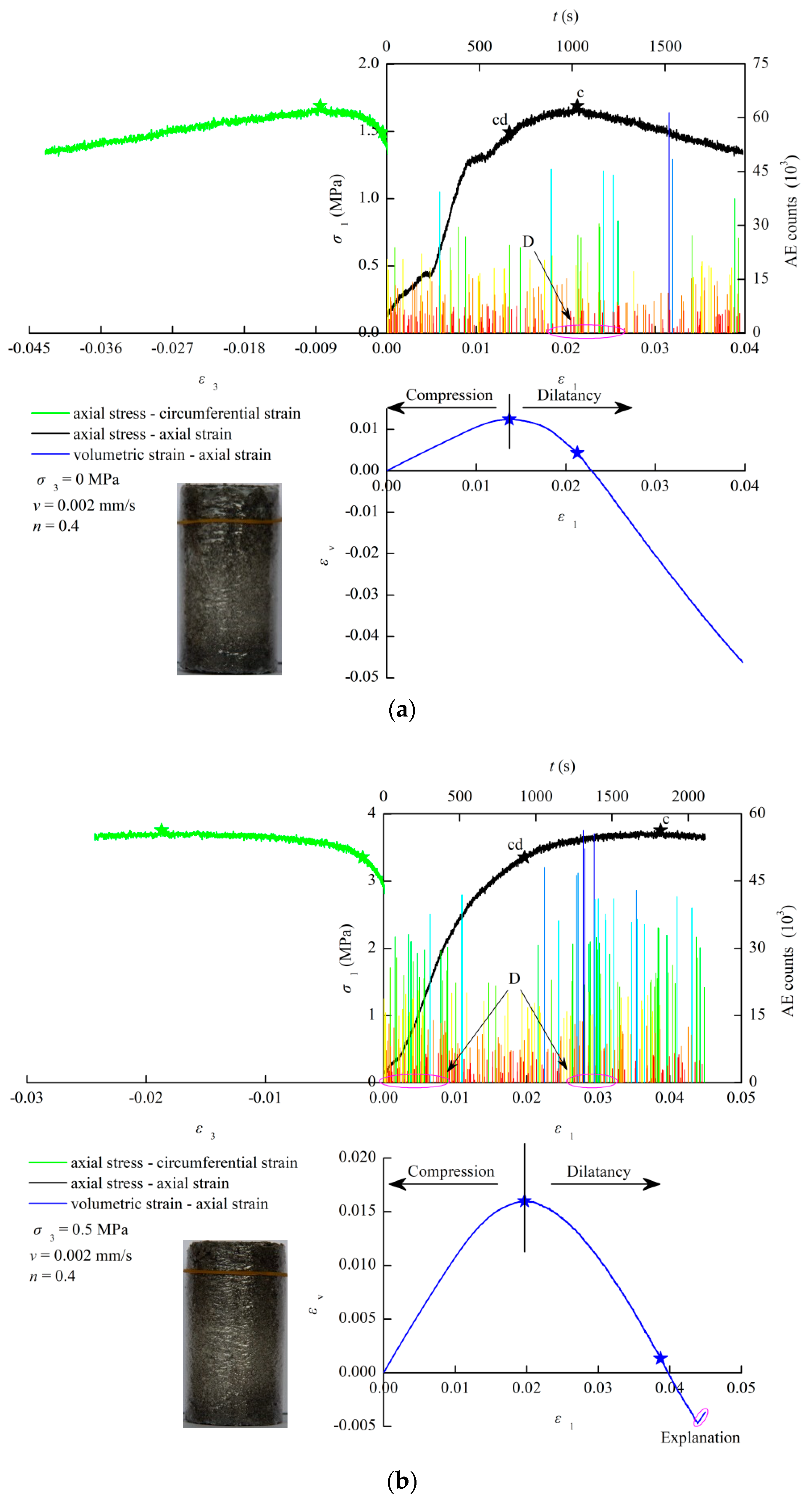

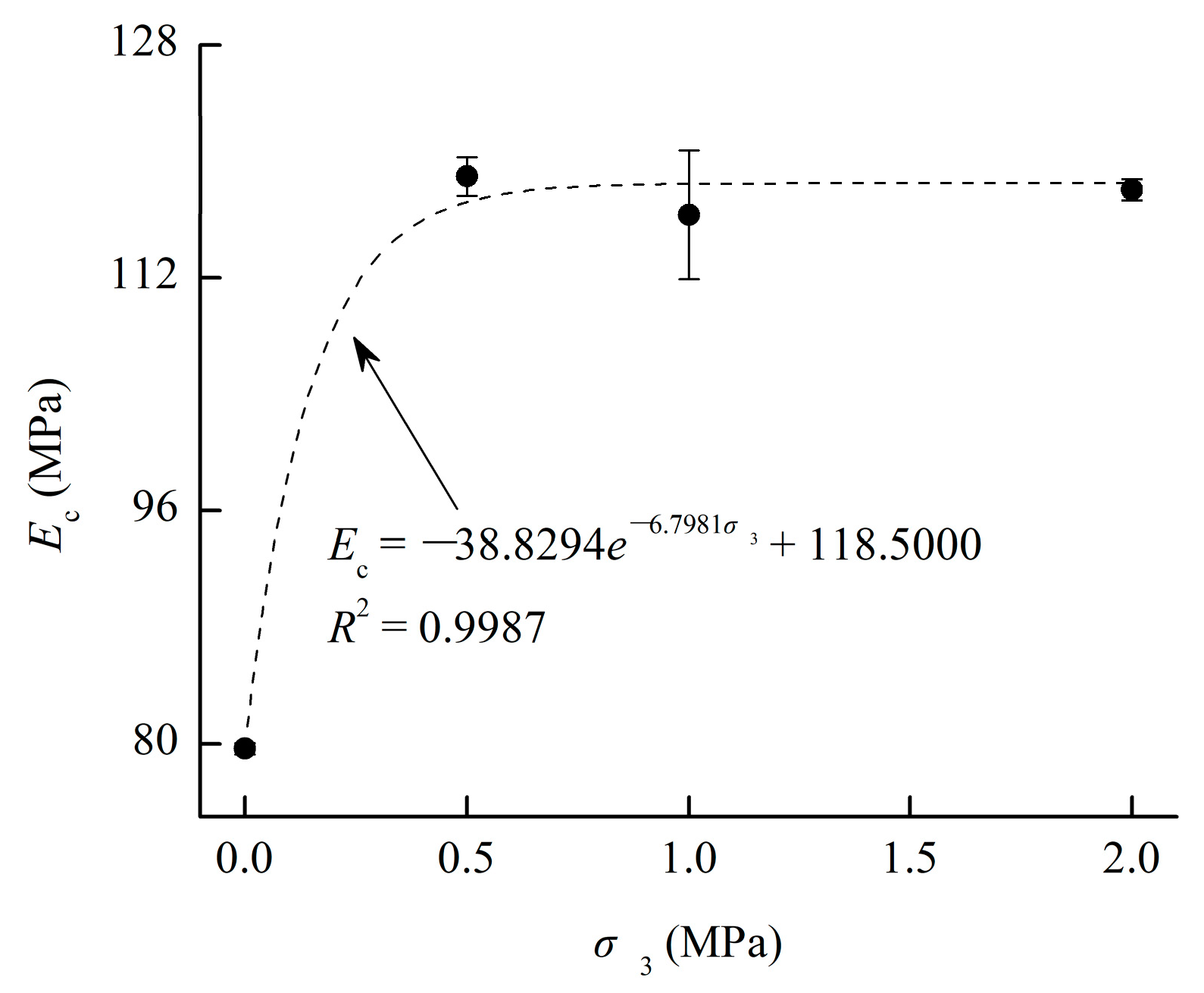
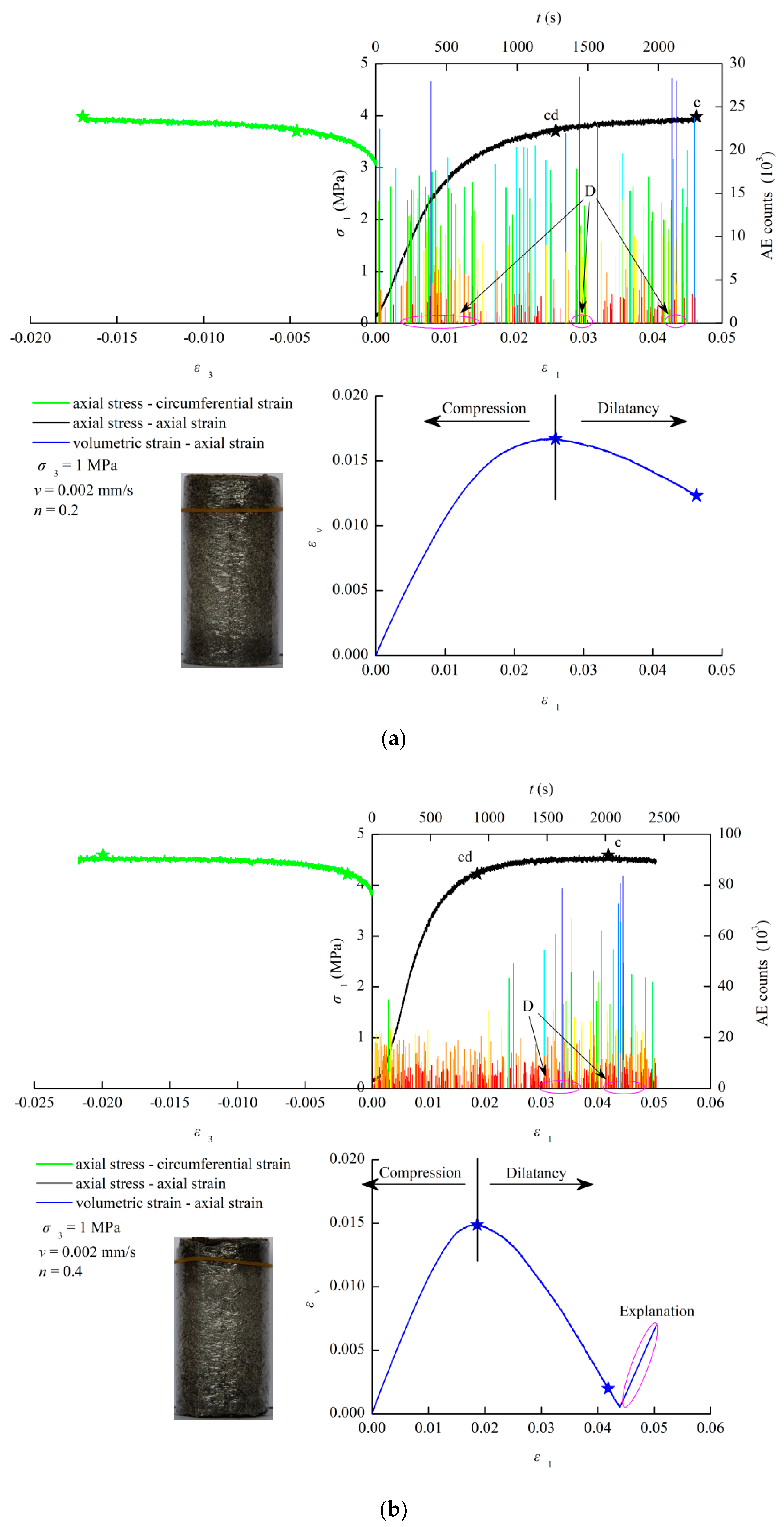
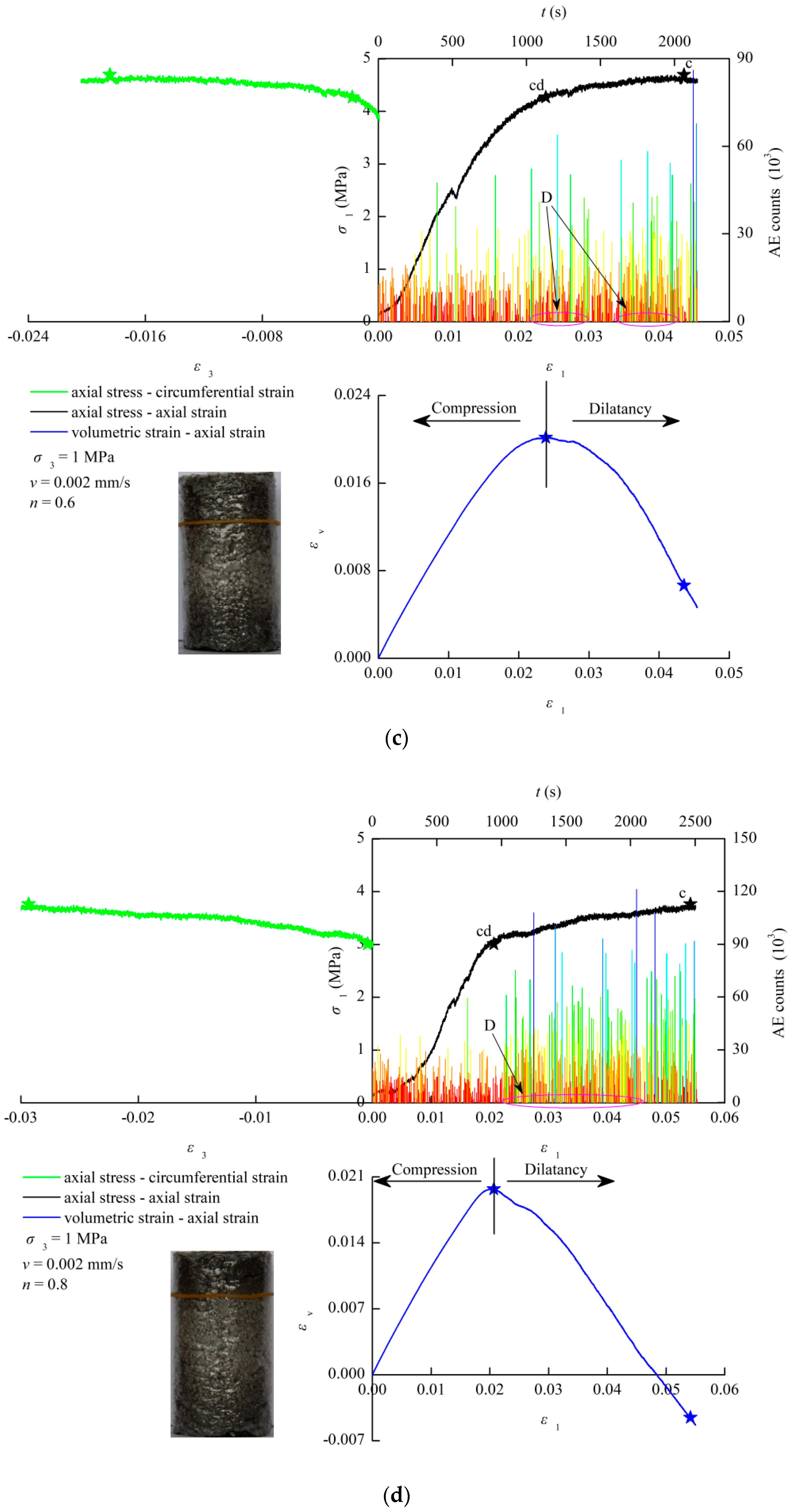
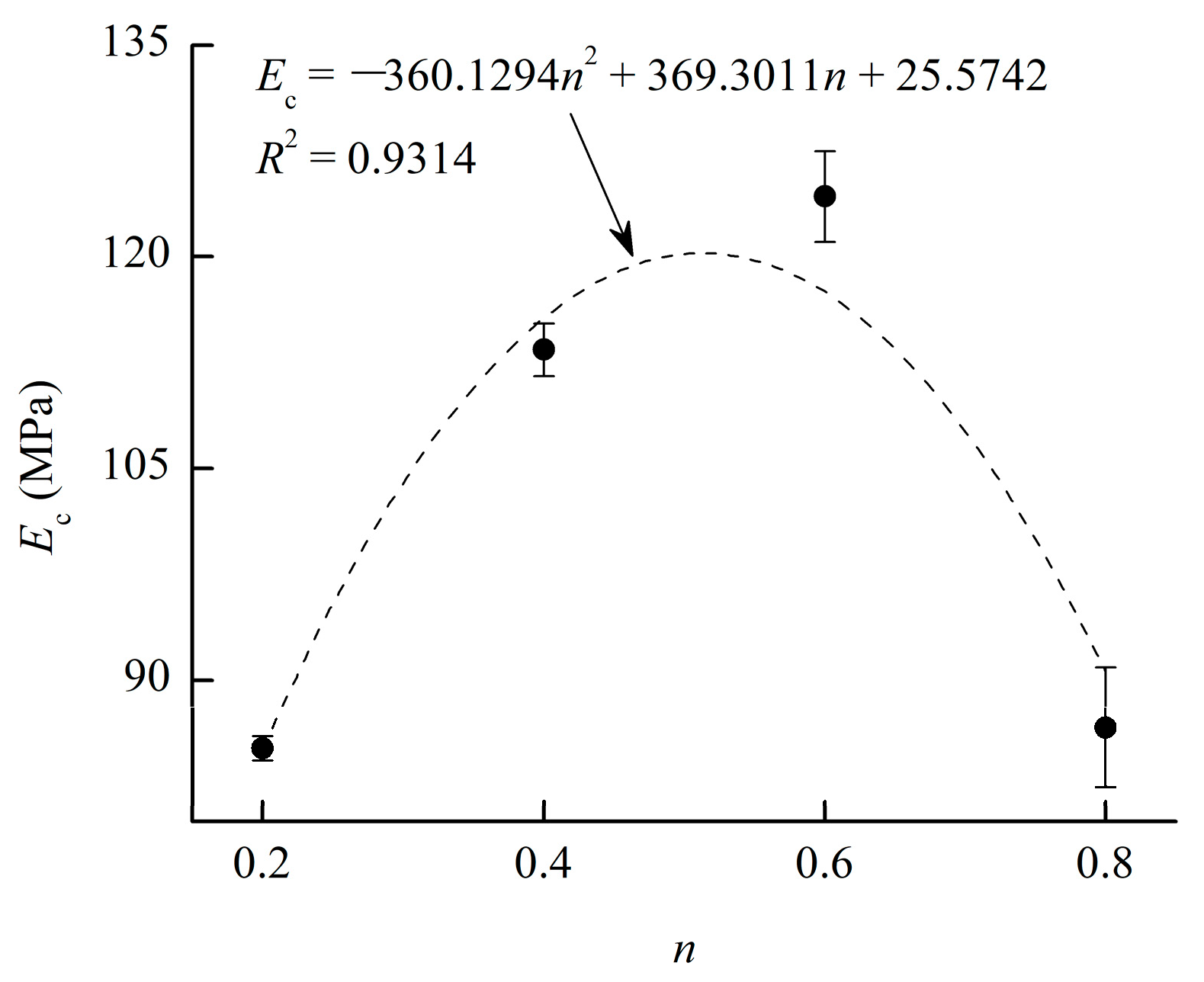
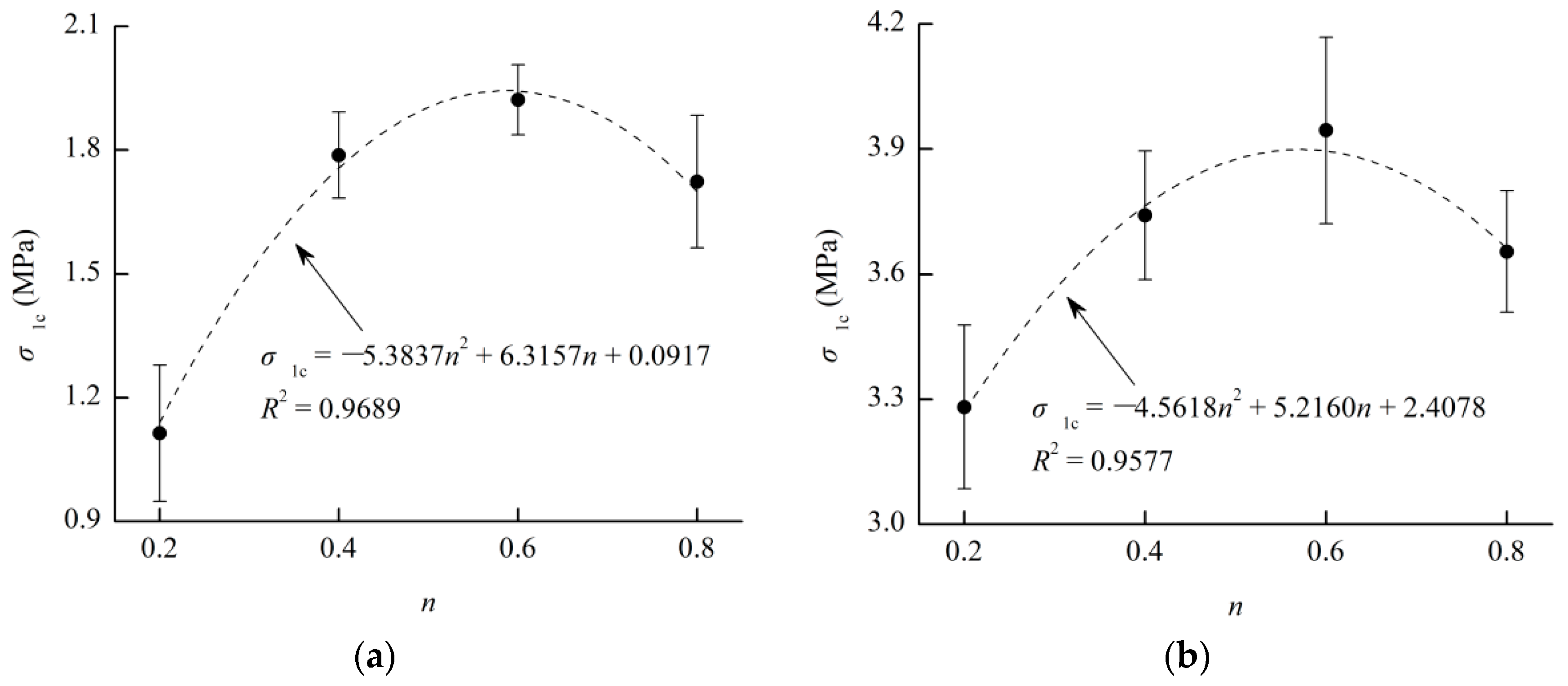


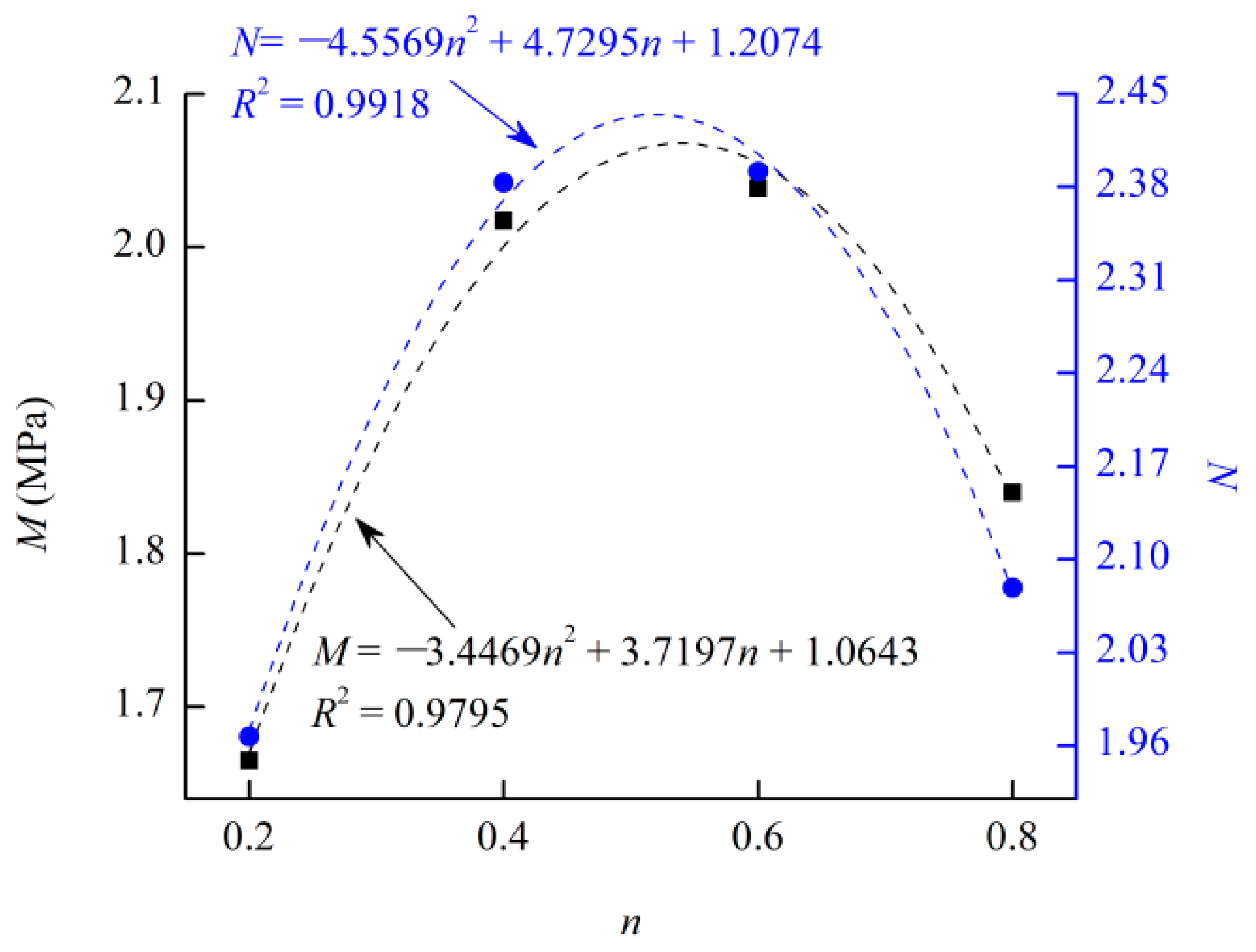
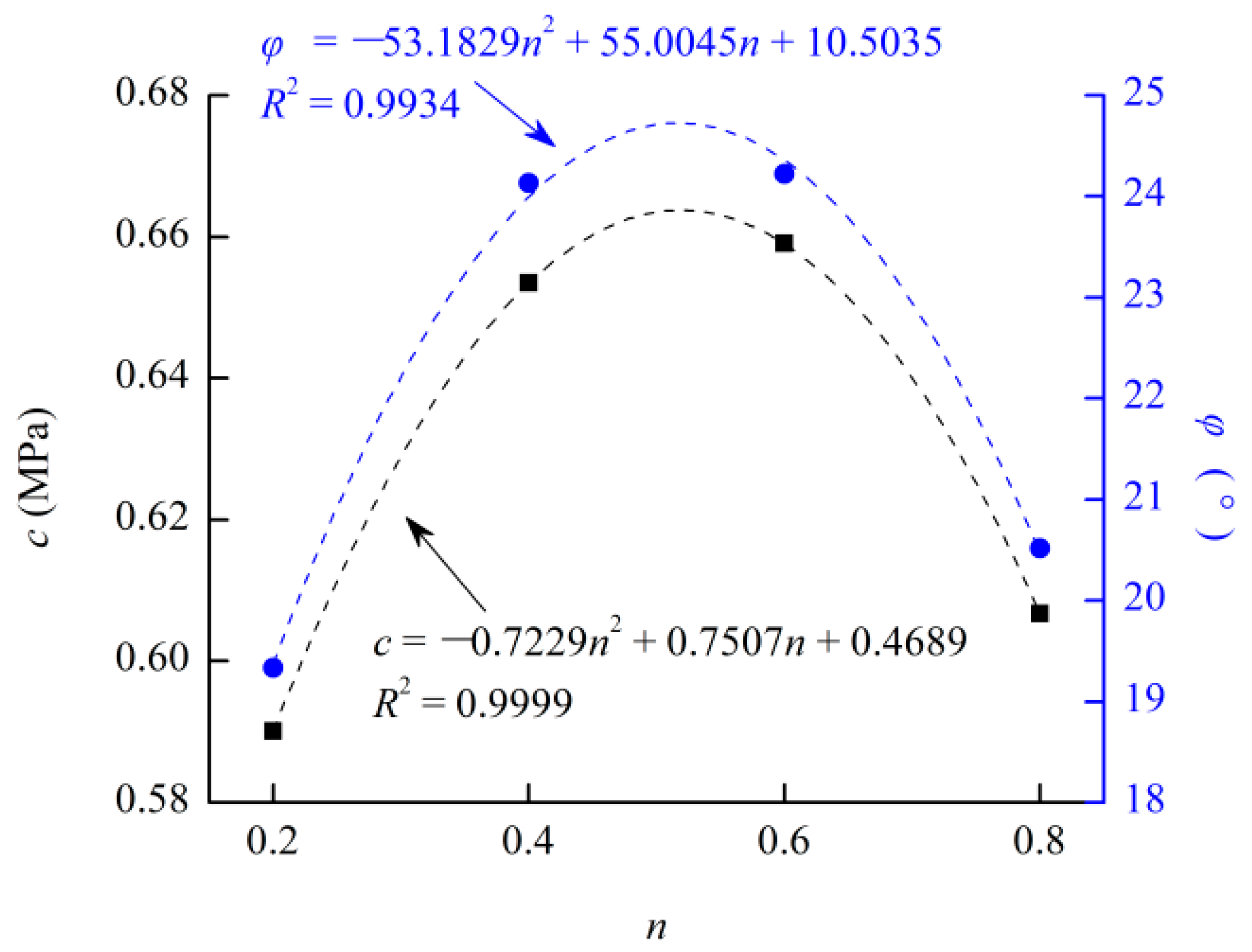

| Varieties (%) | CaO | Al2O3 | SiO2 | MgO | K2O | Fe |
|---|---|---|---|---|---|---|
| Tailings | 3.91 | 13.21 | 67.75 | 2.87 | 0.02 | 3.69 |
| Varieties (%) | CaO | Al2O3 | SiO2 | Fe2O3 | MgO | SO3 | Na2O | K2O | TiO2 |
|---|---|---|---|---|---|---|---|---|---|
| P.C. 32.5R | 62.19 | 4.67 | 21.56 | 3.69 | 2.87 | 1.91 | 0.21 | 0.68 | 0.16 |
| n | Mass (g) of Particles in Different Sizes (mm) | Mass Percent (%) of Particles in Different Sizes (mm) | ||||||||||||
|---|---|---|---|---|---|---|---|---|---|---|---|---|---|---|
| 0–0.5 | 0.5–1 | 1–1.5 | 1.5–2.5 | 2.5–5 | 5.0–8.0 | 8.0–10.0 | 0–0.5 | 0.5–1 | 1–1.5 | 1.5–2.5 | 2.5–5 | 5.0–8.0 | 8.0–10.0 | |
| 0.2 | 164.78 | 24.51 | 15.99 | 22.08 | 33.81 | 25.74 | 13.09 | 54.93 | 8.17 | 5.33 | 7.36 | 11.27 | 8.58 | 4.36 |
| 0.4 | 90.51 | 28.92 | 21.03 | 31.84 | 55.05 | 47.03 | 25.62 | 30.17 | 9.64 | 7.01 | 10.61 | 18.35 | 15.68 | 8.54 |
| 0.6 | 49.72 | 25.64 | 20.76 | 34.47 | 67.34 | 64.48 | 37.59 | 16.57 | 8.55 | 6.92 | 11.49 | 22.45 | 21.49 | 12.53 |
| 0.8 | 27.31 | 20.23 | 18.22 | 33.20 | 73.34 | 78.65 | 49.05 | 9.10 | 6.74 | 6.07 | 11.07 | 24.45 | 26.22 | 16.35 |
| Talbot Index | Type of Cementing Material | Content of Cementing Material m/g | Content of Distilled Water v/mL |
|---|---|---|---|
| 0.2 | Cement | 30 | 22.5 |
| 0.4 | Cement | 30 | 22.5 |
| 0.6 | Cement | 30 | 22.5 |
| 0.8 | Cement | 30 | 22.5 |
| σ3 (MPa) | Relationship | Correlation Coefficient |
|---|---|---|
| 0 | σ1c = −5.3837n2 + 6.3157n + 0.0917 | 0.9689 |
| 0.5 | σ1c = −4.5618n2 + 5.2160n + 2.4078 | 0.9577 |
| 1 | σ1c = −6.6370n2 + 7.2179n + 2.7966 | 0.9160 |
| 2 | σ1c = −10.5912n2 + 11.4653n + 3.1738 | 0.9719 |
| n | Relationship | Correlation Coefficient |
|---|---|---|
| 0.2 | σ1c = 1.9897σ3 + 1.6648 | 0.9043 |
| 0.4 | σ1c = 2.3832σ3 + 2.0175 | 0.8981 |
| 0.6 | σ1c = 2.3916σ3 + 2.0385 | 0.9461 |
| 0.8 | σ1c = 2.0791σ3 + 1.7497 | 0.9160 |
| Parameter | Relationship | Correlation Coefficient |
|---|---|---|
| M | M = −3.4469n2 + 3.7197n + 1.0643 | 0.9795 |
| N | N = −4.5569n2 + 4.7295n + 1.2074 | 0.9918 |
| c | c = −0.7229n2 + 0.7507n + 0.4689 | 0.9999 |
| φ | φ = −53.1829n2 + 55.0045n + 10.5035 | 0.9934 |
© 2018 by the authors. Licensee MDPI, Basel, Switzerland. This article is an open access article distributed under the terms and conditions of the Creative Commons Attribution (CC BY) license (http://creativecommons.org/licenses/by/4.0/).
Share and Cite
Wu, J.; Feng, M.; Chen, Z.; Mao, X.; Han, G.; Wang, Y. Particle Size Distribution Effects on the Strength Characteristic of Cemented Paste Backfill. Minerals 2018, 8, 322. https://doi.org/10.3390/min8080322
Wu J, Feng M, Chen Z, Mao X, Han G, Wang Y. Particle Size Distribution Effects on the Strength Characteristic of Cemented Paste Backfill. Minerals. 2018; 8(8):322. https://doi.org/10.3390/min8080322
Chicago/Turabian StyleWu, Jiangyu, Meimei Feng, Zhanqing Chen, Xianbiao Mao, Guansheng Han, and Yiming Wang. 2018. "Particle Size Distribution Effects on the Strength Characteristic of Cemented Paste Backfill" Minerals 8, no. 8: 322. https://doi.org/10.3390/min8080322






